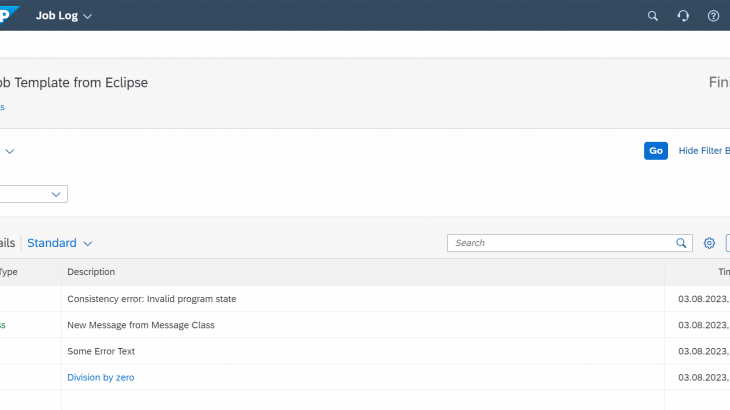In this Blog Post, we will see how to create Application Logs and attach to an Application Job. Application Logs is a reuse library and can be used with other applications as well. This reuse library gives you a clearly structured overview of all errors that might have occurred during runtime.
In your Fiori Launchpad search for application :- Application Logs
Key Features
You can use this reuse library to:
- view application log details
- filter the logs by severity
- search for message texts
- display the message details
Steps Involved:-
- Create Application log Object, Subobject and External reference in ADT.
- Create Job Catalog entry.
- Create Application Job template.
- Writing code in job template class using provided interfaces- IF_APJ_DT_EXEC_OBJECT, IF_APJ_RT_EXEC_OBJECT.
- Writing code for Application Logs
- Execute Job.
Details:
Log Object, SubObject in ADT.
New Object > Others > Application Log Object.
Add your object and Subobject like below code
{
"formatVersion": "1",
"header": {
"description": "new log",
"originalLanguage": "en",
"abapLanguageVersion": "cloudDevelopment"
},
"subobjects": [
{
"name": "ZSUBOBJECT1",
"description": "Subobject 1"
}
]
}Create Job Catalog
New > Others > Application Job Catalog Entry
Here add a custom class

Create Application Job Template
New > Others > Application Job Template
Here provide your created catalog

Now let’s add very simple required code in the class
Interfaces: The two interfaces used are related to job execution, one gets parameters for the job other executes the code, If_oo_adt_classrun is just a reuse interface to run code as an ABAP application to debug or test.
With cl_bali_log=>create_with_header, cl_bali_header_setter=>, Provide your Object and subobject to initiate log object.
Then with cl_bali_message_setter,cl_bali_freetext_setter,cl_bali_exception_setter we have formed all type of logging type messages.
l_log->add_item, adds item to logs.
Then method save_log will write the logs in database.
it may require COMMIT WORK.
Also notice in the code we have a parameter assign_to_current_appl_job, This will attach the logs to the running Application Job itself.
CLASS z_new_job_class_ec DEFINITION
PUBLIC
FINAL
CREATE PUBLIC .
PUBLIC SECTION.
INTERFACES if_apj_dt_exec_object.
INTERFACES if_apj_rt_exec_object.
INTERFACES if_oo_adt_classrun.
PROTECTED SECTION.
PRIVATE SECTION.
ENDCLASS.
CLASS z_new_job_class_ec IMPLEMENTATION.
METHOD if_apj_dt_exec_object~get_parameters.
* You can Insert code here for getting Job parameters
ENDMETHOD.
METHOD if_apj_rt_exec_object~execute.
DATA(l_log) = cl_bali_log=>create_with_header( cl_bali_header_setter=>create( object =
'ZNEWLOG' subobject = 'ZSUBOBJECT1' ) ).
"Add a message as item to the log
DATA(l_message) = cl_bali_message_setter=>create( severity =
if_bali_constants=>c_severity_error
id = 'PO'
number = '000' ).
l_log->add_item( item = l_message ).
"Add a second message, this time from system fields SY-MSGID, ...
MESSAGE ID 'ZTEST' TYPE 'S' NUMBER '058' INTO DATA(l_text).
l_log->add_item( item = cl_bali_message_setter=>create_from_sy( ) ).
"Add a free text to the log
DATA(l_free_text) = cl_bali_free_text_setter=>create( severity =
if_bali_constants=>c_severity_error
text = 'Some Error Text' ).
l_log->add_item( item = l_free_text ).
" Add an exception to the log
DATA: i TYPE i.
TRY.
i = 1 / 0.
CATCH cx_sy_zerodivide INTO DATA(l_ref).
ENDTRY.
DATA(l_exception) = cl_bali_exception_setter=>create( severity =
if_bali_constants=>c_severity_error
exception = l_ref ).
l_log->add_item( item = l_exception ).
"Save the log into the database
cl_bali_log_db=>get_instance( )->save_log( log = l_log assign_to_current_appl_job = abap_true ).
COMMIT WORK.
CATCH cx_bali_runtime INTO DATA(l_runtime_exception).
ENDTRY.
ENDMETHOD.Let’s Test it now.
Create Job from Job template in application:- Application Job

Select your template here via job template description.

Check Scheduling Options

Parameters coming from code in interface:
IF_APJ_DT_EXEC_OBJECT.
Hit Schedule

Log Generated. Click on it.

Job logs:











